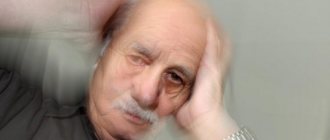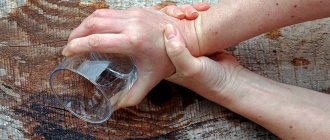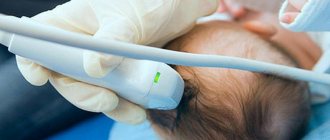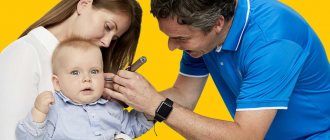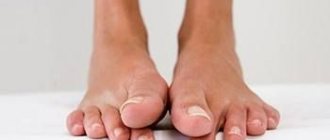Tremor in infants is most often twitching of the arms and chin . Similar to muscle hypertonicity, tremor is considered a sign of a lack of sufficient maturity of the baby’s nervous system and its significant excitability.
Most often, muscle contractions in newborns are recorded periodically during severe fright, screaming, crying, REM sleep (with noticeable eye movements) or feelings of hunger.
If the intensity of tremor in newborns is high and the amplitude is small, then these are the characteristics of the nervous system of the newborn.
Tremor is a fairly common phenomenon, occurring in approximately half of newborns, and is considered normal in the first months of life (by 3-4 months all signs of tremor should disappear).
Chin tremor in a newborn under 1 year of age is also rarely a cause for concern and does not require treatment, since it is often a benign, age-related, specific condition of the nervous system.
However, if parents notice a tremor in a child, it is better to consult a pediatrician.
The baby’s nervous system is very flexible and very susceptible to external influences, so proper treatment can easily normalize and restore it.
Causes of tremors in infants
The most common causes of tremor can be:
- immaturity of the nervous system;
- fetal hypoxia;
- premature birth.
Immaturity of the nervous system
In the first weeks of a baby’s life, he lacks coordination of movements, and the nervous system is immature. These factors cause limb tremors in newborns.
Muscle hypertonicity also increases the likelihood of tremors. Also, during the manifestation of emotions, an increased level of norepinephrine may be observed in the baby’s blood.
Fetal hypoxia
During pregnancy and during childbirth, there is a risk of disturbances in placental blood flow, which can negatively affect processes in the brain. Hypoxia can be a consequence of:
- intrauterine infection;
- dysfunction of the placenta;
- bleeding;
- increased uterine tone (threat of miscarriage);
- polyhydramnios.
Problems with the child’s nervous system can be caused by both rapid labor and weak labor , as well as placental abruption and entanglement of the fetus with the umbilical cord.
The above factors impede the access of oxygen to the brain, which leads to tremor of the arms, legs and chin in newborns.
Premature birth
A premature baby is most often susceptible to tremors of the lips, legs or chin.
This happens because their nervous system, in principle, is not mature. She has to complete her formation outside the mother’s womb, where there are no and cannot be any conditions close to her, even in the case of adequate and careful care.
What you need to know about massage for tremors in a newborn
Massage is one of the most effective ways to get rid of the problem. Its correct implementation helps strengthen the nervous system and relax the baby’s muscles.
All movements must be performed correctly. Therefore, at first, this should be entrusted to a professional. And only after thoroughly mastering the basics of therapeutic massage can you begin to perform it yourself.
Before proceeding with the massage, you must:
- Prepare the room. It should not be too stuffy or cold. Before the massage, it is recommended to ventilate the room for 10 minutes;
- Take care to keep your hands clean. They should be washed, dried, heated to a temperature comfortable for the baby. In order not to injure his delicate skin, fingernails should be short;
- Make sure the child is in a good mood. It is not worth conducting a massage session if he is nervous, capricious, or something is bothering him;
- Make sure you are comfortable. The baby needs to create suitable conditions - the procedure should be carried out in a place that is familiar to him and evokes positive emotions. The best option is a children's room. During the massage, the newborn should remain on a hard surface;
- Don't forget about communication. The procedure will be a joy if the mother talks to the child. This will allow you to get positive emotions, get closer, and win the baby over;
- Avoid using massage oils or creams.
Massage movements are performed in a certain direction - along the joints. They are performed smoothly, gently, slowly. The child should not feel discomfort. As for the pressure force, it is determined by a specialist.
The massage is based on stroking movements, which alternate with:
- Kneading
- Rubbing
- Vibration.
The massage is carried out in the following sequence:
- Hands. You should start with 10 strokes from hand to shoulder, then move on to kneading each finger.
- Rib cage. From the neck to the chest, 10 strokes are carried out with the palms. Movements should resemble a Christmas tree and be smooth.
- Stomach. The palm makes circular movements. Their number is 10 times.
- Legs. They massage like hands - first stroking, then kneading each finger.
- Back. The child should be placed on his stomach and stroked from bottom to top, and then vice versa.
The massage time and the number of times each movement is performed is determined by the specialist. This may depend on the baby's age and condition. For children from 1.5 to 3 months, the recommended massage time is no more than 5 minutes daily.
In what cases is targeted treatment necessary?
If signs of tremor are observed for longer than 3 months, spread to the legs and head, and are not associated with the characteristics of the nervous system or a feeling of hunger, then this should cause alarm among parents.
This may result in:
- intracranial hemorrhage;
- hyperglycemia;
- hypocalcemia;
- hypoxic-ischemic encephalopathy;
- hypomagnesemia;
- drug withdrawal syndrome;
- sepsis and increased intracranial pressure.
Targeted treatment of tremor in newborns is mandatory after a traumatic brain injury or infectious disease.
In such cases, systematic observation should be carried out by a pediatric neurologist.
Physiological (benign) tremor
- Excitement, fear and anxiety are a fairly common explanation for why arms and legs shake. This state is well known to emotional people who are intensely experiencing certain events and who take everything that happens around them to heart. In such situations, people say “the ankles are shaking,” implying feelings of strong excitement. Once a person calms down, the tremor disappears on its own.
- Prolonged physical stress is another cause of involuntary trembling of the limbs. Professional athletes, people whose profession involves strenuous work with small objects (jewelers, watchmakers, surgeons), as well as loaders - it is not uncommon for them to experience muscle trembling under tension.
Figure 2 - Why do the hands of young and old people shake?
- Trembling limbs in infants is often due to the fact that their nervous system is not fully formed. Temporary tremor occurs under the influence of various stimuli: for example, the child is hungry, scared, does not want to bathe, change clothes, etc., and against the background of all this, rhythmic muscle contraction can be observed. Of course, parents need to ensure that the baby is monitored by a specialist to make sure that the baby’s development is progressing normally (tremors are often observed in the first months of a child’s life in cases where there was a difficult pregnancy and/or birth injuries).
- Hand trembling at a young age can be associated not only with anxiety (for example, during exams), physical overexertion during sports training, but even with ordinary hypothermia. The latter sometimes leads to involuntary muscle contraction, resulting in shaking hands. Another reason for shaking hands in teenagers is hormonal imbalances.
- People who abuse alcoholic beverages and also take various stimulants (drugs, tranquilizers) deserve special attention. Why are their hands shaking? Alcohol and drugs overstimulate nerve cells (resulting in uncontrolled muscle contraction), which can lead to damage to the nervous system and brain.
Figure 3 - Addiction to alcohol is one of the reasons why hands shake
It should be noted that temporary trembling of the hands can be a consequence of the effects of tonic drinks (strong tea, coffee), as well as medications. Before taking any medicine, you need to carefully study the instructions - tremor may be indicated in the side effects section (some chemical compounds, affecting the psychoneurological sphere, cause undesirable consequences).
If trembling of the limbs is a functional disorder, it is enough to eliminate the provoking factor, and the unpleasant phenomenon will go away on its own. For example, in case of alcohol poisoning, it is necessary to detoxify the body, and hand tremors will disappear (provided that at this stage brain damage has not yet occurred and toxic polyneuropathy has not developed). If the tremor bothers you for a long time (more than two weeks), you need to undergo an examination.
Treatment methods
The treatment method for tremor of the arms, legs, and head in a child is aimed at restoring the health of the baby in general and the nervous system in particular.
The recommendations of a pediatric neurologist should be strictly followed.
Massage for tremors in infants
In addition, parents definitely need to create a pleasant, cozy and friendly environment around their baby, systematically massage their baby (it promotes relaxation), instill swimming skills (this is possible even in a home bath), and do therapeutic exercises with him.
Such efforts of parents will not be in vain.
The easiest way to master massage techniques for newborns (from the age of 5-6 weeks) at home. The pediatrician will definitely teach mom and dad basic massage movements, based on which you can then proceed to perform a variety of exercises.
The basic massage movements are:
- vibration;
- kneading;
- trituration;
- stroking.
The basic rule is that all massage movements are performed from the periphery to the center (along the joints).
An important role is played by the baby’s psychological mood and his physical comfort during the massage:
- The room needs to be ventilated, this will take 20-30 minutes (if the weather is warm outside, then the massage can be performed with the window open);
- Hands must be dry, bracelets and rings must be removed, nails must be trimmed;
- Before starting the massage, you should shake your hands and rub your palms together so that they become warm;
- The massage session is carried out during the baby’s active waking hours; it is always necessary to ensure that he is in a good mood. If the mood deteriorates, you need to stop for a while, cheer up the child and you can continue;
- The place where the massage is performed should be familiar to the baby; it is convenient to do it on the changing table;
- Nothing should disturb the child, for example, the sun shining in his eyes;
- When doing a massage, it is useful to talk with the baby, smile, sing songs, it is better if the facial expressions are emotionally rich;
- Massage is always accompanied by stroking;
- There is no need to use aromatic oils or powder so as not to clog delicate pores (it is better to use regular products used for daily moisturizing for massage purposes);
- The highest effect of massage is observed before water procedures;
- Movements should be smooth. The massage begins with the face: in this case, it is necessary to stroke the baby along the edges and along the wings of the nose.
How tick-borne borreliosis manifests itself - symptoms and signs that will leave no doubt.
Is it possible for newborns to use the medicine Diacarb? We have collected reviews from doctors and patients, contraindications and indications for the medication in one review.
Basic exercises
Here are some basic exercises:
- "Hammer" . When the child is lying on his back, you need to clasp the right foot with one hand and tap the outside of the leg from bottom to top with the fist of the other. Next, the exercise is repeated with the foot of the other leg.
- “Stroking our hands . The baby's arm is fixed with the left hand, and the right hand gently clasps the shoulder. When lowering to the wrist, you should make shaking movements. Do the exercise 2-3 times and move on to the other hand. Using similar tactics, you can perform the “Stroking the Legs” exercise.
- "Watch" . Exercise also helps children with intestinal problems. The baby's tummy should be stroked clockwise for 5-7 minutes.
- "Toptyzhka" . The baby lies on his tummy, and the masseur gently kneads his buttocks with his fists. To keep your baby occupied, it is recommended to place a bright, interesting toy in front of him. He will look at her, reach for her, and thus the back and neck muscles will be activated.
- "Herringbone" . In the direction from the back to the coccyx and at an angle to the spine, it is necessary to make stroking movements.
Treatment of tremor in newborns
Having learned that a child has a tremor, the normal reaction of parents is to contact the doctor to receive recommendations on subsequent treatment. At this stage, experts rush to reassure worried mothers and fathers when it comes to the physiological form of tremor.
In this case, the baby does not need treatment. All it takes is time. As the child gets older, the problem should disappear. This happens differently for all children. Some get rid of this feature after reaching 1 month, while others need a little more time (up to 3 months). If the twitching of the limbs, chin, and lips does not go away, it is worth visiting a specialist and sorting out this issue.
In the case of pathological tremor, everything is much more serious. In this case, treatment begins with visiting a specialist and establishing the cause of its appearance. After this, the appropriate treatment is selected, which should be supervised by a doctor.
What is the treatment:
- Taking medications;
- Performing gymnastics;
- Carrying out a massage.
Effective treatment requires proper massage and gymnastics. This will make the therapy effective and safe for children. Parents can also learn her skills. This will allow treatment to be carried out at home. They can learn this from specialists.
In addition to the main therapy, the normalization of the baby’s condition largely depends on the atmosphere at home. Therefore, it is necessary to protect him from domestic troubles, screams and other things. You can also sign up for swimming - this will help you cope with the problem faster and give you the opportunity to get tremendous pleasure from such a pastime.
conclusions
Pediatrics operates with the concept of a critical time for a child’s development after birth, especially with regard to the nervous system, disturbances in the functioning of which can cause tremors in newborns.
The 1st, 3rd, 9th and 12th months of a baby’s life are considered critical periods, when nerve endings are highly sensitive and any deviation from the norm can lead to the development of certain pathologies.
To prevent the development of serious problems that may be the cause of tremors, systematic monitoring of the child’s health is strongly recommended. If you notice signs of tremor in a newborn, there is no need to panic, but you should definitely contact a neurologist.
Consequences of tremor in a newborn
With physiological tremor, parents should not worry and exhaust themselves with frightening assumptions. The child is not in any danger, and apart from minor twitching of certain parts of the body, this does not affect his development and health in any way.
Up to 3-4 months this feature will disappear on its own. In some children, it completely disappears by the age of one year. Upon reaching this age, the nervous system is strengthened, so there is no trace of the problem.
In the case of pathological tremor, things are somewhat different. In addition to the fact that he needs constant monitoring, he also needs special treatment.
When talking about possible consequences, you need to understand that they completely depend on which part of the brain is affected. There is a possibility that the child will become completely healthy. And in some cases this can result in:
- Intellectual development disorder
- Development of cerebral palsy.
In order to avoid such consequences, you should not hesitate when tremor appears. A visit to a specialist will help determine the cause of its occurrence and possible solutions to the problem. Timely treatment and compliance with the recommendations given by the neurologist will increase the chances that tremor will not affect the child’s health and development.
